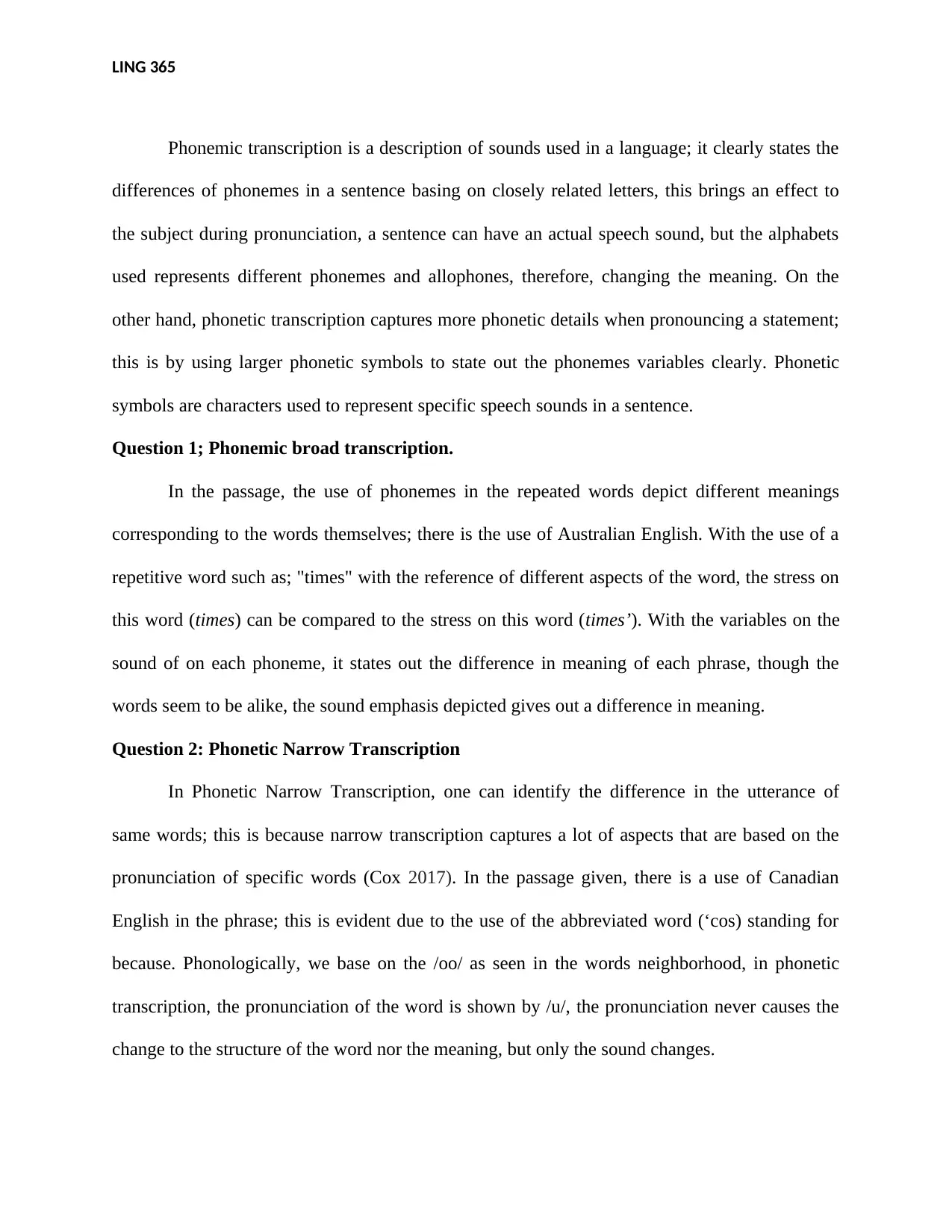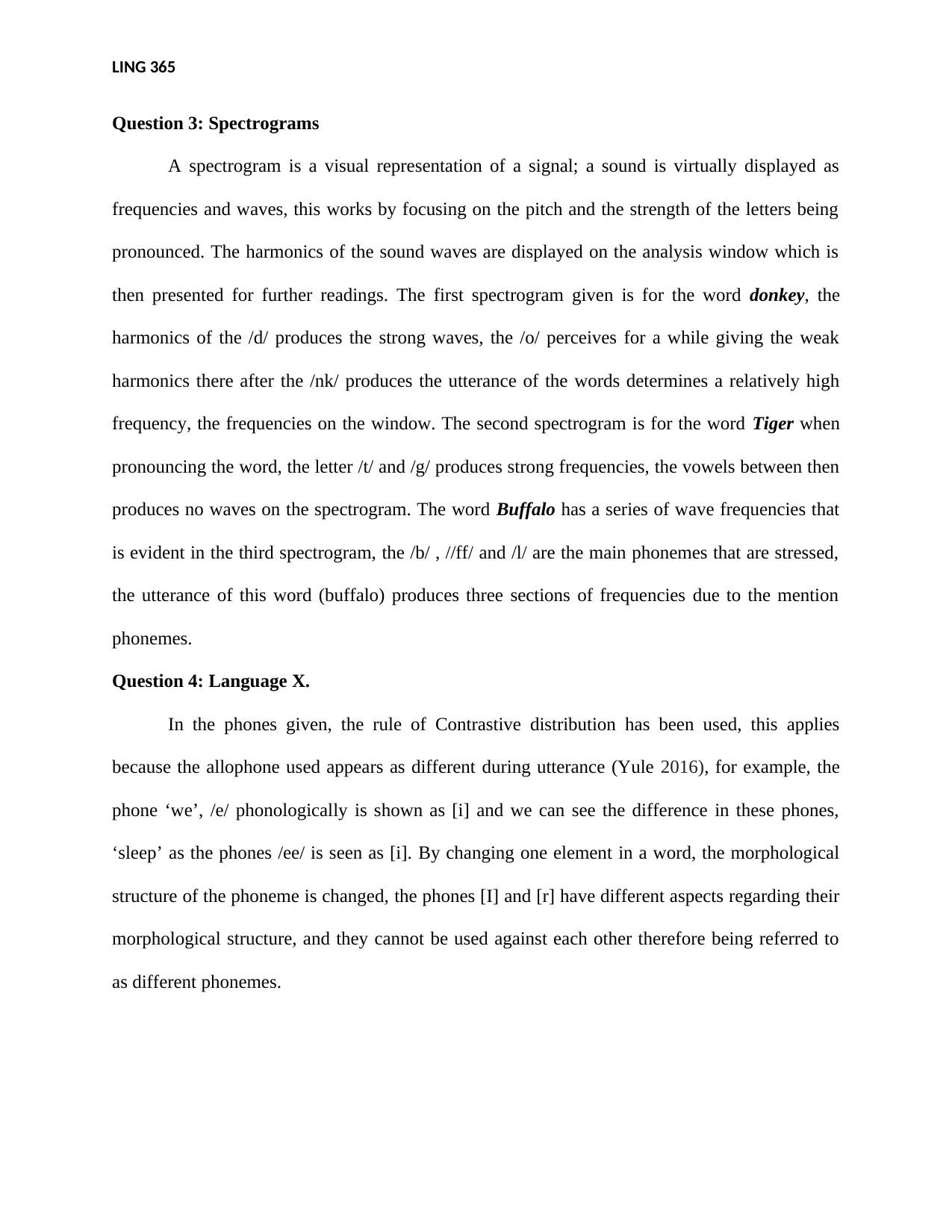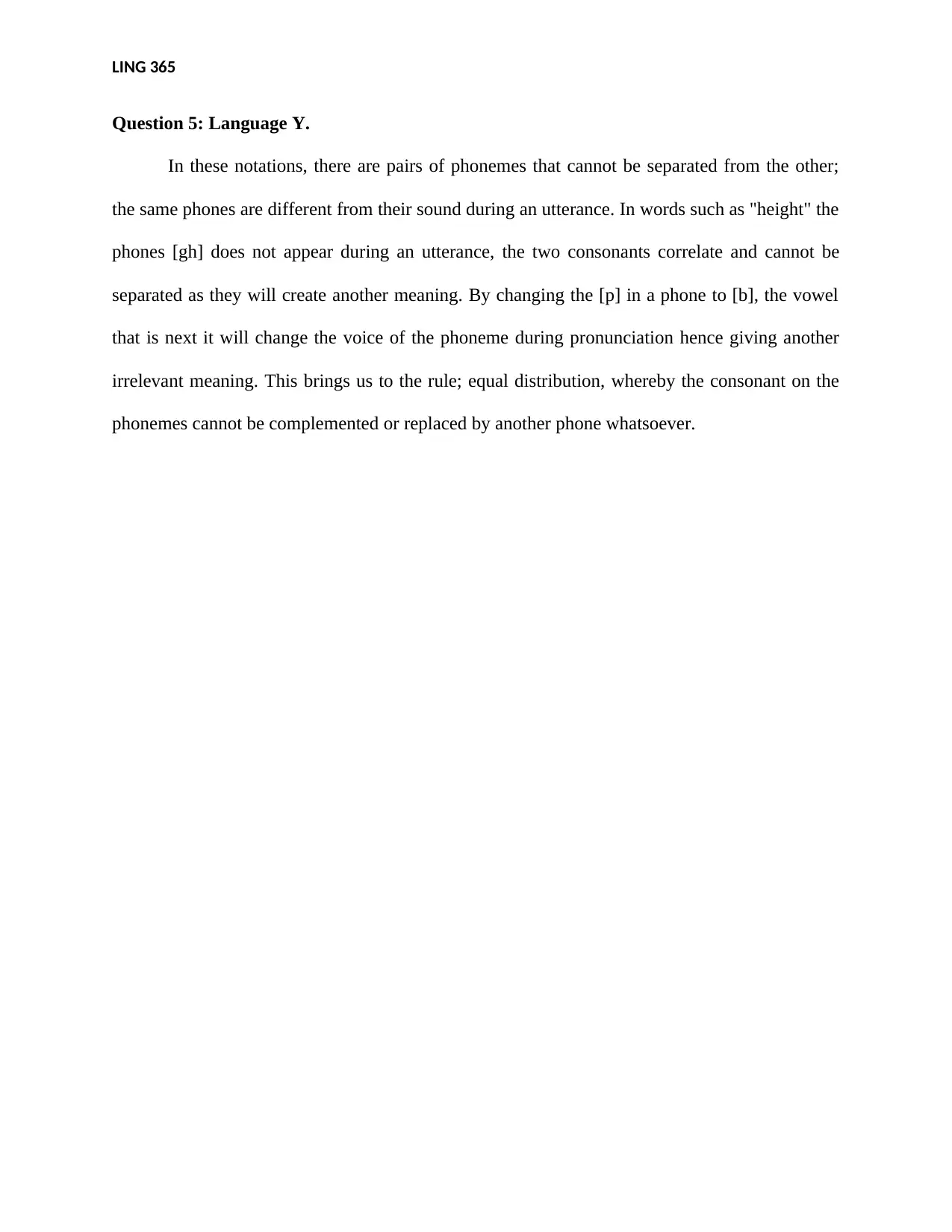LING365/LING565 Worksheet 1: Phonetics, Transcription Analysis
VerifiedAdded on 2023/06/08
|4
|867
|405
Homework Assignment
AI Summary
This LING365/LING565 assignment solution delves into phonetics, focusing on phonemic and phonetic transcription, spectrogram analysis, and language-specific phonetic rules. It examines Australian and Canadian English examples, highlighting the nuances of pronunciation and phoneme usage. The assignment also analyzes spectrograms of words like 'donkey,' 'tiger,' and 'buffalo,' interpreting the visual representation of sound frequencies. Furthermore, it explores contrastive distribution and phoneme pairing rules in hypothetical languages X and Y, demonstrating how sound variations can alter word meaning. Desklib provides access to this and many other solved assignments to aid students in their studies.

LING 365
Phonemic transcription is a description of sounds used in a language; it clearly states the
differences of phonemes in a sentence basing on closely related letters, this brings an effect to
the subject during pronunciation, a sentence can have an actual speech sound, but the alphabets
used represents different phonemes and allophones, therefore, changing the meaning. On the
other hand, phonetic transcription captures more phonetic details when pronouncing a statement;
this is by using larger phonetic symbols to state out the phonemes variables clearly. Phonetic
symbols are characters used to represent specific speech sounds in a sentence.
Question 1; Phonemic broad transcription.
In the passage, the use of phonemes in the repeated words depict different meanings
corresponding to the words themselves; there is the use of Australian English. With the use of a
repetitive word such as; "times" with the reference of different aspects of the word, the stress on
this word (times) can be compared to the stress on this word (times’). With the variables on the
sound of on each phoneme, it states out the difference in meaning of each phrase, though the
words seem to be alike, the sound emphasis depicted gives out a difference in meaning.
Question 2: Phonetic Narrow Transcription
In Phonetic Narrow Transcription, one can identify the difference in the utterance of
same words; this is because narrow transcription captures a lot of aspects that are based on the
pronunciation of specific words (Cox 2017). In the passage given, there is a use of Canadian
English in the phrase; this is evident due to the use of the abbreviated word (‘cos) standing for
because. Phonologically, we base on the /oo/ as seen in the words neighborhood, in phonetic
transcription, the pronunciation of the word is shown by /u/, the pronunciation never causes the
change to the structure of the word nor the meaning, but only the sound changes.
Phonemic transcription is a description of sounds used in a language; it clearly states the
differences of phonemes in a sentence basing on closely related letters, this brings an effect to
the subject during pronunciation, a sentence can have an actual speech sound, but the alphabets
used represents different phonemes and allophones, therefore, changing the meaning. On the
other hand, phonetic transcription captures more phonetic details when pronouncing a statement;
this is by using larger phonetic symbols to state out the phonemes variables clearly. Phonetic
symbols are characters used to represent specific speech sounds in a sentence.
Question 1; Phonemic broad transcription.
In the passage, the use of phonemes in the repeated words depict different meanings
corresponding to the words themselves; there is the use of Australian English. With the use of a
repetitive word such as; "times" with the reference of different aspects of the word, the stress on
this word (times) can be compared to the stress on this word (times’). With the variables on the
sound of on each phoneme, it states out the difference in meaning of each phrase, though the
words seem to be alike, the sound emphasis depicted gives out a difference in meaning.
Question 2: Phonetic Narrow Transcription
In Phonetic Narrow Transcription, one can identify the difference in the utterance of
same words; this is because narrow transcription captures a lot of aspects that are based on the
pronunciation of specific words (Cox 2017). In the passage given, there is a use of Canadian
English in the phrase; this is evident due to the use of the abbreviated word (‘cos) standing for
because. Phonologically, we base on the /oo/ as seen in the words neighborhood, in phonetic
transcription, the pronunciation of the word is shown by /u/, the pronunciation never causes the
change to the structure of the word nor the meaning, but only the sound changes.
Paraphrase This Document
Need a fresh take? Get an instant paraphrase of this document with our AI Paraphraser

LING 365
Question 3: Spectrograms
A spectrogram is a visual representation of a signal; a sound is virtually displayed as
frequencies and waves, this works by focusing on the pitch and the strength of the letters being
pronounced. The harmonics of the sound waves are displayed on the analysis window which is
then presented for further readings. The first spectrogram given is for the word donkey, the
harmonics of the /d/ produces the strong waves, the /o/ perceives for a while giving the weak
harmonics there after the /nk/ produces the utterance of the words determines a relatively high
frequency, the frequencies on the window. The second spectrogram is for the word Tiger when
pronouncing the word, the letter /t/ and /g/ produces strong frequencies, the vowels between then
produces no waves on the spectrogram. The word Buffalo has a series of wave frequencies that
is evident in the third spectrogram, the /b/ , //ff/ and /l/ are the main phonemes that are stressed,
the utterance of this word (buffalo) produces three sections of frequencies due to the mention
phonemes.
Question 4: Language X.
In the phones given, the rule of Contrastive distribution has been used, this applies
because the allophone used appears as different during utterance (Yule 2016), for example, the
phone ‘we’, /e/ phonologically is shown as [i] and we can see the difference in these phones,
‘sleep’ as the phones /ee/ is seen as [i]. By changing one element in a word, the morphological
structure of the phoneme is changed, the phones [I] and [r] have different aspects regarding their
morphological structure, and they cannot be used against each other therefore being referred to
as different phonemes.
Question 3: Spectrograms
A spectrogram is a visual representation of a signal; a sound is virtually displayed as
frequencies and waves, this works by focusing on the pitch and the strength of the letters being
pronounced. The harmonics of the sound waves are displayed on the analysis window which is
then presented for further readings. The first spectrogram given is for the word donkey, the
harmonics of the /d/ produces the strong waves, the /o/ perceives for a while giving the weak
harmonics there after the /nk/ produces the utterance of the words determines a relatively high
frequency, the frequencies on the window. The second spectrogram is for the word Tiger when
pronouncing the word, the letter /t/ and /g/ produces strong frequencies, the vowels between then
produces no waves on the spectrogram. The word Buffalo has a series of wave frequencies that
is evident in the third spectrogram, the /b/ , //ff/ and /l/ are the main phonemes that are stressed,
the utterance of this word (buffalo) produces three sections of frequencies due to the mention
phonemes.
Question 4: Language X.
In the phones given, the rule of Contrastive distribution has been used, this applies
because the allophone used appears as different during utterance (Yule 2016), for example, the
phone ‘we’, /e/ phonologically is shown as [i] and we can see the difference in these phones,
‘sleep’ as the phones /ee/ is seen as [i]. By changing one element in a word, the morphological
structure of the phoneme is changed, the phones [I] and [r] have different aspects regarding their
morphological structure, and they cannot be used against each other therefore being referred to
as different phonemes.

LING 365
Question 5: Language Y.
In these notations, there are pairs of phonemes that cannot be separated from the other;
the same phones are different from their sound during an utterance. In words such as "height" the
phones [gh] does not appear during an utterance, the two consonants correlate and cannot be
separated as they will create another meaning. By changing the [p] in a phone to [b], the vowel
that is next it will change the voice of the phoneme during pronunciation hence giving another
irrelevant meaning. This brings us to the rule; equal distribution, whereby the consonant on the
phonemes cannot be complemented or replaced by another phone whatsoever.
Question 5: Language Y.
In these notations, there are pairs of phonemes that cannot be separated from the other;
the same phones are different from their sound during an utterance. In words such as "height" the
phones [gh] does not appear during an utterance, the two consonants correlate and cannot be
separated as they will create another meaning. By changing the [p] in a phone to [b], the vowel
that is next it will change the voice of the phoneme during pronunciation hence giving another
irrelevant meaning. This brings us to the rule; equal distribution, whereby the consonant on the
phonemes cannot be complemented or replaced by another phone whatsoever.
⊘ This is a preview!⊘
Do you want full access?
Subscribe today to unlock all pages.

Trusted by 1+ million students worldwide

LING 365
References.
Cox, F., & Fletcher, J. (2017). Australian English pronunciation and transcription. Cambridge
University Press.
Yule, G. (2016). The study of languages. Cambridge University Press.
References.
Cox, F., & Fletcher, J. (2017). Australian English pronunciation and transcription. Cambridge
University Press.
Yule, G. (2016). The study of languages. Cambridge University Press.
1 out of 4
Your All-in-One AI-Powered Toolkit for Academic Success.
+13062052269
info@desklib.com
Available 24*7 on WhatsApp / Email
![[object Object]](/_next/static/media/star-bottom.7253800d.svg)
Unlock your academic potential
Copyright © 2020–2025 A2Z Services. All Rights Reserved. Developed and managed by ZUCOL.

